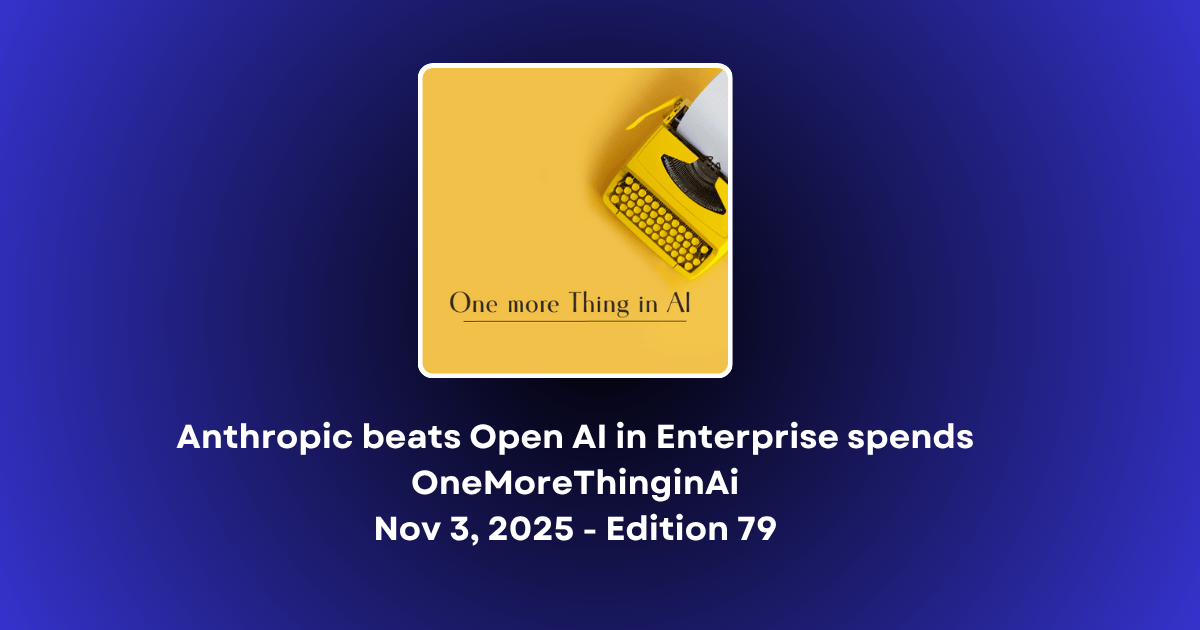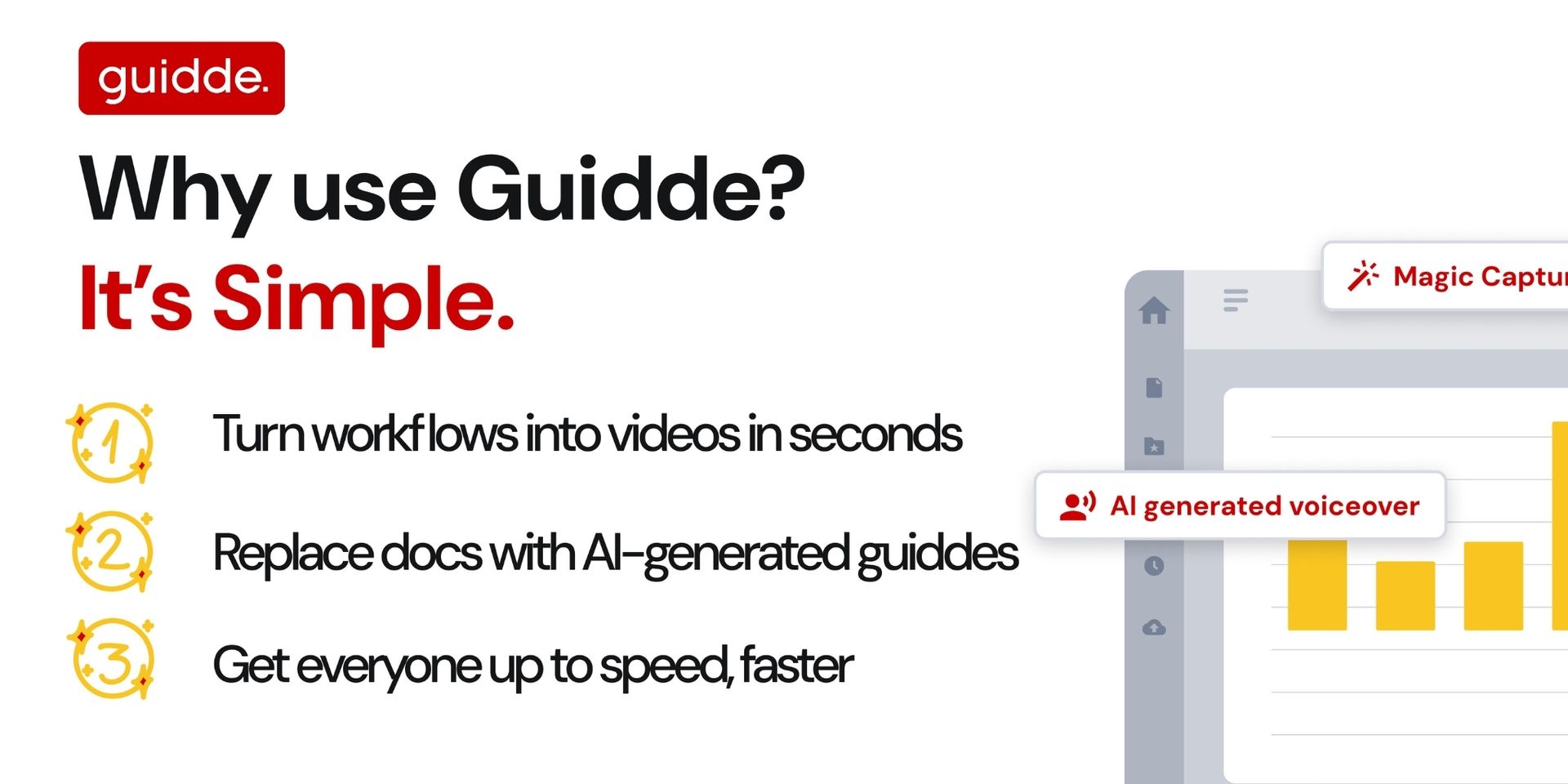Date: 2-Nov-2025
Hey {{first_name | AI enthusiast}},
And just when you think you’ve seen it all…there’s always One More Thing in AI.
In this edition:
Also: introducing you to our podcast edition for those of you who want to listen to it on the go. Check it out on your favorite platforms:
I hope you enjoy this edition!
Best,
Renjit
PS: If you want to check out how to implement AI agents in your business and get more revenue with the same number of employees, speak to me:
Wharton report on how Gen AI has become an Everyday Enterprise Tool
Three years ago, executives treated Generative AI as a novelty. Today, it’s as common as email in many workplaces. A new Wharton and GBK Collective study, “Accountable Acceleration: Gen AI Fast-Tracks Into the Enterprise,” shows a clear shift, from early curiosity to disciplined adoption where impact and accountability now drive the agenda.
Let’s unpack the findings through three key themes shaping the next phase of enterprise AI.

1. Everyday AI: From Pilots to Practice
Gen AI is now part of the daily workflow.
• 46% of business leaders use it daily, and over 80% engage weekly.
• IT and procurement teams lead adoption, while marketing and operations still lag. 🧭
• Large enterprises have closed the gap with smaller firms, proving scale is no longer a blocker.
• High-performing use cases include data analysis, document summarization, and contract drafting real productivity work, not just demos.
Leaders are also getting more confident. More executives now see themselves as “competent” or “expert” users. Still, a cultural divide remains. The best-performing companies treat access and experimentation as a cultural norm, not a privilege.
Those who limit exposure risk falling behind as AI-enhanced employees outpace them.
2. Proving Value: The ROI Reality
The “AI for AI’s sake” phase is over. Enterprises are now tracking measurable outcomes.
• 72% of leaders track ROI using metrics like profitability, throughput, and productivity.
• Three in four companies already see positive returns, especially in tech, telecom, and banking. 💡
• Budgets are shifting from pilots to performance-proven programs, with 30% of AI budgets now spent on internal R&D.
Even as optimism grows, 88% expect increased spend in the next year, leaders are also applying financial discipline. Many now fund AI projects by reallocating from legacy IT or HR budgets.
The conversation has matured: not “if” AI delivers, but “how much and how soon.”
3. The Human Capital Lever: Talent, Training, and Trust
AI may automate tasks, but people still set the pace.
• Executive leadership in AI adoption has jumped 16 points, with Chief AI Officers now in 60% of enterprises.
• Companies are tightening guardrails (data security and policy frameworks are up nearly 10%) while expanding access. 🤝
• Yet, training is slipping, down 8 points, and confidence in upskilling has fallen even more.
The paradox: while 89% of leaders believe AI enhances skills, fewer are investing in employee readiness. This talent gap is emerging as the biggest drag on ROI. Hiring AI experts is expensive, but skipping workforce training creates long-term risk.
Mid-managers tend to favor employee-led innovation and training, while senior leaders lean toward top-down strategies. The companies that balance both empowering employees while setting clear accountability are pulling ahead.
The Takeaway
AI in the enterprise has entered its accountability era. The winners will be those who blend performance rigor with human investment, treating AI not as a side project, but as part of the company’s operating DNA.
Leaders are learning that Gen AI success isn’t just about better algorithms. It’s about better alignment between people, process, and purpose. Link to the report»
AI & Error- The Travel Assistant That Thinks With You
(Logistics, not data)
Guest Column by Nisha Pillai.
I needed to book a complex multi-stop international trip involving unusual destinations. The kind of itinerary that makes you open twelve browser tabs, cross-reference flight search engines, and eventually give up and call a travel agent.
This time, I asked Claude to pitch in. In minutes, it mapped out realistic routes, confirmed that no nonstop flights existed on the routes I wanted, and explained why certain departure dates worked better based on available connections. It reasoned through layovers, flagged potential tight connections, and considered time zones. The whole thing felt less like using a search tool and more like brainstorming with a well-traveled friend who actually understands logistics.
This wasn't just faster than my usual approach. It was fundamentally different.
Where it gets really useful
Then I started researching activities. I'd found a dining experience that looked perfect—the kind of thing travel blogs rave about. So I asked the AI about it. It pulled together reviews, logistics, and pricing from multiple sources. Fine. That's useful but not revolutionary. Then I mentioned who would be in my travel group.
The recommendation changed entirely. The AI flagged that the experience is recommended for certain ages, requires formal dress, and involves a multi-hour evening commitment in a set format. All details that marketing materials gloss over but that would absolutely make or break the experience for a group trip.This was the first moment it felt like decision intelligence — not search. The AI wasn’t optimizing for popularity; it was optimizing for fit.
This would have taken me an hour of cross-referencing review sites and digging through fine print. But more importantly, the AI essentially said, "This might not work for your situation." It steered me away from an expensive mistake rather than just serving up the most popular option.
The thing nobody tells you
It is very important to note that the AI didn't do the thinking for me; its responses built on clear thinking. This principle applies to prompting in general: good prompts emerge from clear thinking, not clever wording.
Ask "where should I go on vacation in December," and you'll get results that aren't much better than results from a Google search. Generic suggestions. Top 10 lists. The usual suspects. Ask for warm places that are a nonstop flight from San Francisco, no more than 6 hours away, with a vibrant food culture and art scene where you can walk around safely—now you're getting somewhere. The AI becomes useful when you've done the hard work of knowing what you actually want.
It's not magic. It's leverage for people who know what questions to ask.
What's still missing
For all its strengths in research and planning, AI still isn’t the best choice when it's time to actually buy tickets or reserve hotels. Do the thinking and exploration with AI, then context-switch to traditional tools to execute.
The ideal experience would integrate both—AI for exploration and strategy, real-time booking systems for execution. We're not there yet. That gap between exploration and execution is where the next generation of AI-native tools will compete. Whoever closes that loop will redefine how we move from idea to action. But even in its current form, AI has changed how I approach trip planning. Especially for complex, multi-stop itineraries where I need to think through logistics before I'm ready to book anything.
Will I use it every time I travel? Probably not. For a simple weekend getaway or a hotel in a city I know well, the old tools work fine. But for trips that require actual research and strategic thinking about routes, timing, and activities? AI is now my starting point.
What pain point should I tackle next—or should I finally test whether AI can handle something truly mundane, like sorting through my email archives and clearing out the stuff I don’t need? Either way, the next experiment begins where curiosity meets constraint.
———-
Nisha Pillai transforms complexity into clarity for organizations from Silicon Valley startups to Fortune 10 enterprises. A patent-holding engineer turned MBA strategist, she bridges technical innovation with business execution—driving transformations that deliver measurable impact at scale. Known for her analytical rigor and grounded approach to emerging technologies, Nisha leads with curiosity, discipline, and a bias for results. Here, she is testing AI with healthy skepticism and real constraints—including limited time, privacy concerns, and an allergy to hype. Some experiments work. Most don't. All get documented here.
Anthropic beats Open AI on Enterprise spends
Are LLMs the new utility in your business toolkit, or just another line item on your tech budget? Mid-2025 gives us a clear answer.
The Menlo Ventures mid-year report reveals not just soaring spend on language models, but also new winners and unexpected shakeups at the top of the market.
Here’s what you need to know:
- Model API spending has more than doubled this year. Production use for inference, not just experimentation, fuels this surge.
- Anthropic has overtaken OpenAI as the new leader in enterprise LLM usage: 32% market share, while OpenAI drops to 25%. Google climbs to 20% on Gemini’s momentum.

Source Menlo Ventures
- Code generation has emerged as AI’s first breakout app. Developers love Claude, which now owns 42% of this space double OpenAI’s share.
- Three trends drive Anthropic’s leap: clear success in code tools; reinforcement learning with verifiers (RLVR); and training models as step-by-step “agents” that can use other tools.
- Open-source adoption in enterprises has flattened at 13%. Most prefer closed-source for now, thanks to tougher technical and performance barriers in open-source.
- When picking models, companies prioritize performance. Cost savings from older models? Not as attractive as the gains from the newest, fastest LLMs.

Source Menlo Ventures
- Most teams don’t switch vendors. They upgrade within their chosen platform; new releases trigger fast upgrades, while only 11% jump providers.
- Spending is shifting: 74% of startups and nearly half of large companies say “inference”, actually running models in production is now their biggest compute cost. Training, though still hefty, is no longer the focus.
The bottom line:
The market is maturing. Performance matters most, and “good enough” is getting left behind. Enterprises are moving fast, sticking with providers that deliver—while also betting on agents and advanced training methods to future-proof their competitive edge.
This LLM playbook is still being written. But one thing is certain: If you’re not keeping up, you risk getting left out of the next wave. For founders and leaders, that’s both a warning and an opportunity. Source»
Revolutionize Learning with AI-Powered Video Guides
Upgrade your organization training with engaging, interactive video content powered by Guidde.
Here’s what you’ll love about it:
1️⃣ Fast & Simple Creation: AI transforms text into video in moments.
2️⃣ Easily Editable: Update videos as fast as your processes evolve.
3️⃣ Language-Ready: Reach every learner with guides in their native tongue.
Bring your training materials to life.
The best part? The browser extension is 100% free.
OpenAI’s New For Profit Chapter: From Capped Profits to Global Impact
Three years ago, few could imagine that OpenAI, the startup that began as a nonprofit lab, would become a $500 billion public benefit corporation. Yet here we are.
The company has now completed its transformation into OpenAI Group PBC, a for-profit entity still governed by its original nonprofit foundation.
The move marks the end of OpenAI’s unusual “capped-profit” era, where investors could earn only (!) up to 100 times their initial investment. This structure, once seen as a safeguard for mission integrity, had grown increasingly complex as OpenAI scaled and sought new funding.
A Dual Structure for a Dual Purpose
The nonprofit foundation isn’t going away. Instead, it will focus on two big goals backed by a $25 billion commitment:
• Health and curing diseases 🧬
The foundation plans to fund open-sourced health datasets and accelerate medical breakthroughs in diagnostics, treatments, and cures.
• Technical solutions for AI resilience
This effort aims to strengthen AI safety and ensure technology remains aligned with human benefit.
In short, the foundation becomes the guardian of mission, while the PBC drives the engine of innovation and capital.
The Microsoft Deal That Redefines Partnership
Alongside the reorganization, OpenAI inked a new long-term deal with Microsoft. The tech giant now owns about 27% of the company, roughly $135 billion in value. A great outcome!
The agreement extends Microsoft’s rights to OpenAI’s models and products until 2032, including those developed after AGI is reached. Earlier deal excluded Microsoft from the fruits of AGI.
In return, Microsoft gave up certain veto rights and exclusivity clauses. That means both sides now have more flexibility - Microsoft can pursue its own AGI efforts, while OpenAI gains the room to scale beyond its primary partner.
This restructuring effectively ends the “first buildout” phase of OpenAI’s journey and sets the stage for broader commercialization.
The Road to a Record-Breaking IPO
OpenAI’s next milestone? A potential IPO valued at $1 trillion. Internal talks point to a late 2026 filing, with a listing in 2027. The company aims to raise at least $60 billion, which would make it the largest IPO in history.
The transformation signals something bigger than a financial maneuver; it’s the maturation of an idea. OpenAI is now both a mission-driven foundation and a global tech powerhouse.
Its next challenge: proving that innovation and accountability can scale together. The world will be watching.


